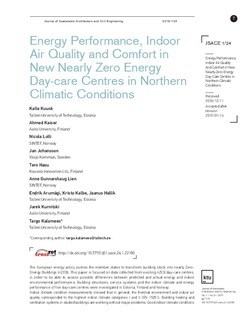| dc.contributor.author | Kuusk, Kalle | |
| dc.contributor.author | Kaiser, Ahmed | |
| dc.contributor.author | Lolli, Nicola | |
| dc.contributor.author | Johansson, Jan | |
| dc.contributor.author | Hasu, Tero | |
| dc.contributor.author | Lien, Anne Gunnarshaug | |
| dc.contributor.author | Arumägi, Endrik | |
| dc.contributor.author | Kalbe, Kristo | |
| dc.contributor.author | Hallik, Jaanus | |
| dc.contributor.author | Kurnitski, Jarek | |
| dc.contributor.author | Kalamees, Targo | |
| dc.date.accessioned | 2019-07-07T07:59:42Z | |
| dc.date.available | 2019-07-07T07:59:42Z | |
| dc.date.created | 2019-07-04T15:22:13Z | |
| dc.date.issued | 2019 | |
| dc.identifier.issn | 2335-2000 | |
| dc.identifier.uri | http://hdl.handle.net/11250/2603702 | |
| dc.description.abstract | The European energy policy pushes the member states to transform building stock into nearly Zero-Energy Buildings (nZEB). This paper is focused on data collected from existing nZEB day-care centres,in order to be able to assess possible differences between predicted and actual energy and indoor environmental performance. Building structures, service systems and the indoor climate and energy performance of five day-care centres were investigated in Estonia, Finland and Norway.Indoor climate condition measurements showed that in general, the thermal environment and indoor airquality corresponded to the highest indoor climate categories I and II (EN 15251). Building heating andventilation systems in studied buildings are working without major problems. Good indoor climate conditions were also reflected in the occupant satisfaction questionnaires. For most of the studied buildings, over 80%of the people marked all indoor environment condition parameters (thermal comfort, indoor air quality,acoustics, odour and illuminance) acceptable. The thermal environment in the cooling season was reported problematic because it was lower than the minimum temperature for indoor climate category II.Energy consumption analysis showed that measured real energy use was higher, or even significantly higher, than the energy use calculated during the design phase. Potential causes of the higher actual energy consumption are caused by differences of measured and designed solutions, methodology of theenergy calculations, and the differences in user behaviour.Lessons learnt from previously constructed day-care centres can be utilised in the planning and design of new nZEBs. | nb_NO |
| dc.language.iso | eng | nb_NO |
| dc.publisher | KTU | nb_NO |
| dc.subject | Indoor thermal conditions | nb_NO |
| dc.subject | Indoor air quality | nb_NO |
| dc.subject | Occupant satisfaction | nb_NO |
| dc.subject | Energy consumption | nb_NO |
| dc.subject | nZEB | nb_NO |
| dc.subject | Day-care centres | nb_NO |
| dc.title | Energy Performance, Indoor Air Quality and Comfort in New Nearly Zero Energy Day-care Centres in Northern Climatic Conditions | nb_NO |
| dc.type | Journal article | nb_NO |
| dc.description.version | publishedVersion | nb_NO |
| dc.rights.holder | Copyright terms are indicated in the Republic of Lithuania Law on Copyright and Related Rights, Articles 4-37. | nb_NO |
| dc.subject.nsi | VDP::Teknologi: 500 | nb_NO |
| dc.source.volume | 24 | nb_NO |
| dc.source.journal | Journal of sustainable architecture and civil engineering | nb_NO |
| dc.source.issue | 1 | nb_NO |
| dc.identifier.doi | 10.5755/j01.sace.24.1.22180 | |
| dc.identifier.cristin | 1710195 | |
| cristin.unitcode | 7401,30,40,0 | |
| cristin.unitname | Arkitektur, byggematerialer og konstruksjoner | |
| cristin.ispublished | true | |
| cristin.fulltext | original | |
